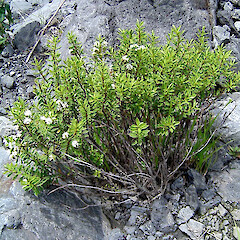Veronica rupicola
Common name
hebe
Synonyms
Hebe rupicola (Cheeseman) Cockayne et Allan
Family
Plantaginaceae
Flora category
Vascular – Native
Endemic taxon
Yes
Endemic genus
No
Endemic family
No
Structural class
Trees & Shrubs - Dicotyledons
NVS code
The National Vegetation Survey (NVS) Databank is a physical archive and electronic databank containing records of over 94,000 vegetation survey plots - including data from over 19,000 permanent plots. NVS maintains a standard set of species code abbreviations that correspond to standard scientific plant names from the Ngä Tipu o Aotearoa - New Zealand Plants database.
HEBRUP
Chromosome number
2n = 40
Current conservation status
The conservation status of all known New Zealand vascular plant taxa at the rank of species and below were reassessed in 2017 using the New Zealand Threat Classification System (NZTCS) – more information about this can be found on the NZTCS website. This report includes a statistical summary and brief notes on changes since 2012 and replaces all previous NZTCS lists for vascular plants.
Please note, threat classifications are often suggested by authors when publications fall between NZTCS assessment periods – an interim threat classification status has not been assessed by the NZTCS panel.
- Conservation status of New Zealand indigenous vascular plants, 2017 . 2018. Peter J. de Lange, Jeremy R. Rolfe, John W. Barkla, Shannel P. Courtney, Paul D. Champion, Leon R. Perrie, Sarah M. Beadel, Kerry A. Ford, Ilse Breitwieser, Ines Schönberger, Rowan Hindmarsh-Walls, Peter B. Heenan and Kate Ladley. Department of Conservation. Source: NZTCS and licensed by DOC for reuse under the Creative Commons Attribution 4.0 International licence.
2017 | Not Threatened
Previous conservation statuses
2012 | Not Threatened
2009 | Not Threatened
2004 | Not Threatened
Brief description
Low growing sprawling shrub bearing pairs of glossy green oval leaves inhabiting the Kaikoura mountains. Leaves 7-21mm long by 5-7mm wide, obviously wider towards tip. Leaf bud with narrow gap between leaves at base. Flowers white, base hidden by green scales, in spikes to 5cm long.
Distribution
Endemic to Marlborough and north Canterbury, South Island, between the Chalk Range in the northeast and the Mason Range in the southwest.
Habitat
Grows mostly on cliffs or other rocky areas, often near rivers.
Detailed description
Low-growing bushy shrub to 0.8 (-1.5) m tall. Branches decumbent or ascending or erect, old stems brown: branchlets green (but dark when dry), pubescent or puberulent, hairs bifarious (usually in broad bands between leaf decurrencies); internodes (1-) 2-9 (-18) mm; leaf decurrencies extended for length of internode and often swollen. Leaf bud distinct; sinus narrow and acute. Leaves erecto-patent to patent; lamina elliptic (mostly) or oblanceolate, coriaceous, slightly concave, (4-) 7-21 (-24) x (2-) 5-7 (-9) mm; apex acute to obtuse; midrib thickened below and depressed to grooved above (but evident above to varying extents); margin minutely papillate and sometimes ciliolate or glandular-ciliate; upper surface light green or yellowish-green, dull, with many stomata, glabrous or hairy along midrib; lower surface light green or sometimes glaucous or glaucescent; petiole (1-) 2-4 (-5) mm, hairy along margins (usually) and hairy above (often) or glabrous. Inflorescences with (5-) 9-37 flowers, lateral, unbranched or tripartite, 1.3-3 (-4.7) cm, longer than (usually) to shorter than subtending leaves; peduncle (0.3-) 0.6-1.7 (-2) cm; rachis (0.7-) 1-2.1 (-2.9) cm. Bracts large, opposite and decussate, free (usually) or connate (sometimes, and then very shortly), ovate or lanceolate, acute (mostly) or subacute or obtuse. Flowers hermaphrodite or female (on different plants). Pedicels usually absent but if evident then always shorter than bracts, 0-1 mm. Calyx 3-4 (-5) mm, with anterior lobes free for most of their length or united 1/4-½-way to apex (degree of fusion can vary in one inflorescence); lobes ovate or lanceolate, subacute or obtuse. Corolla tube glabrous; tube of hermaphrodite flowers 3-4.9 x 1.5-2.3 mm, funnelform (narrowly) or cylindric, longer than (usually) or equalling calyx; lobes white at anthesis, ovate (sometimes narrowly) or lanceolate, subacute or obtuse, suberect to recurved, shorter to longer than corolla tube. Stamen filaments white, 3.3-4.2 mm; anthers white or buff or pink or mauve or violet, 1.3-1.7 mm; sterile anthers 0.6-0.8 mm (on herbarium specimens). Ovary approximately 1-1.3 mm; ovules 8-9 per locule; style 5.5-8.3 mm. Capsules obtuse, 4-4.5 x 2.3-3.2 mm, loculicidal split extending ¼-½-way to base. Seeds flattened, ovoid to obovoid-oblong, straw-yellow to pale brown, 1.4-2.2 x 0.9-1.4 mm, micropylar rim 0.5-0.7 mm.
Similar taxa
Has most commonly been confused with V. rigidula, which is a similar small shrub of rocky areas and also has a sinus in the leaf bud. It can be distinguished from this and other similar species by the possession of large bracts that surround and almost completely obscure the calyces. It also differs from V. rigidula in having longer calyces (3-4 (-5) mm), and leaves that are usually duller green above.
Flowering
December-February (-March)
Flower colours
White
Fruiting
(January-) February-May (-October)
Etymology
veronica: Named after Saint Veronica, who gave Jesus her veil to wipe his brow as he carried the cross through Jerusalem, perhaps because the common name of this plant is ‘speedwell’. The name Veronica is often believed to derive from the Latin vera ‘truth’ and iconica ‘image’, but it is actually derived from the Macedonian name Berenice which means ‘bearer of victory’.
rupicola: From the Latin rupes ‘rock, cliff’ and -cola ‘dweller’, refers to the usual habitat of the species
Taxonomic notes
The localities “Key Summit” (Livingstone Mountains, Southland, given on CHR 33033) and “Aorere River ford” (North West Nelson, given on CHR 468465) are not likely to be correct.
Attribution
Description adapted by M. Ward from Bayly & Kellow (2006).
References and further reading
Bayly, M.J., Kellow, A.V. 2006. An illustrated guide to New Zealand Hebes. Wellington, N.Z.: Te Papa press pg. 236.
NZPCN Fact Sheet citation
Please cite as: Ward, M.D. (Year at time of access): Veronica rupicola Fact Sheet (content continuously updated). New Zealand Plant Conservation Network. https://www.nzpcn.org.nz/flora/species/veronica-rupicola/ (Date website was queried)


